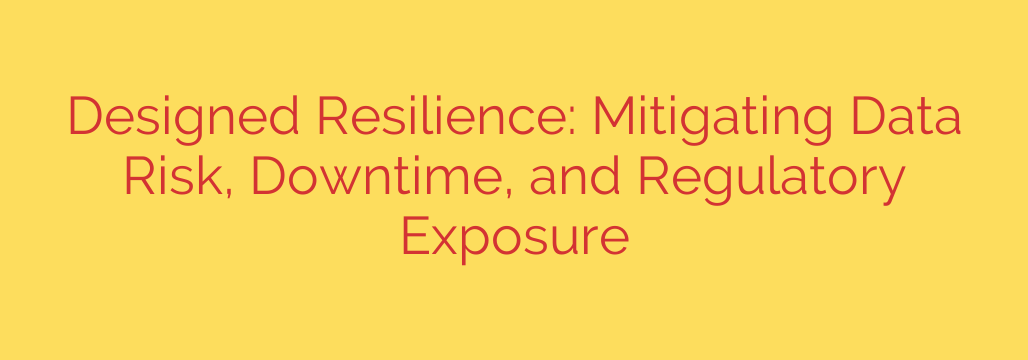
Resilience by Design: Your Modern Playbook for Mitigating Risk and Downtime
In today’s hyper-connected world, the conversation around business continuity has fundamentally changed. It’s no longer enough to have a dusty disaster recovery (DR) plan sitting on a shelf. The modern threat landscape—a volatile mix of sophisticated cyberattacks, supply chain disruptions, and stringent regulatory pressures—demands a more proactive and integrated approach. This is the principle of Resilience by Design, a strategy that weaves security and availability into the very fabric of your IT infrastructure.
Simply put, traditional disaster recovery is reactive. It answers the question, “What do we do after something breaks?” Resilience by Design is proactive. It asks, “How do we build our systems to withstand failure without disrupting the business?” This shift in mindset is crucial for survival and success in the digital age.
The Evolving Nature of Business Risk
The risks facing organizations today are more complex and carry steeper consequences than ever before. A simple hardware failure is now the least of many worries. Modern enterprises must contend with:
- Sophisticated Cyberattacks: Ransomware is no longer a simple data-locking event. Attackers now engage in double or triple extortion, stealing data before encrypting it and threatening to release it publicly if the ransom isn’t paid.
- Crippling Downtime: The cost of downtime is staggering. Beyond the immediate financial losses from stalled operations, the long-term reputational damage can erode customer trust and market position.
- Intense Regulatory Scrutiny: Regulations like GDPR, CCPA, and others impose heavy fines for data breaches and non-compliance. Demonstrating robust data protection and recovery capabilities is no longer optional—it’s a legal requirement.
- Human Error and System Failures: Despite advances in technology, simple mistakes and unexpected system glitches remain a significant cause of outages and data loss.
Relying on an outdated active/passive DR model, where a secondary site sits idle waiting for a disaster, is a recipe for failure. These environments are rarely tested, often misconfigured, and typically unable to handle the speed and complexity of a modern cyberattack.
The Core Pillars of a Modern Resilience Strategy
Building a truly resilient organization requires a multi-layered approach. It’s about ensuring that your data, applications, and operations can collectively withstand disruption. This strategy is built on four key pillars.
1. Advanced Data Protection and Rapid Recovery
Modern data protection goes far beyond nightly backups. To be resilient, your data strategy must assume that an attack will happen and be prepared to recover instantly and cleanly.
- Immutability and Air Gaps: Your backup data must be unchangeable (immutable) and logically or physically isolated (air-gapped). This ensures that even if your primary systems are compromised by ransomware, you have a pristine, untouchable copy of your data ready for recovery.
- Focus on Recovery Time and Point Objectives (RTO/RPO): Your goal should be near-zero RTO (the time it takes to recover) and RPO (the amount of data you can afford to lose). This requires technology that enables instant data access and recovery, not a multi-day restoration process.
Security Tip: Implement the 3-2-1-1-0 rule of data protection: Maintain at least 3 copies of your data, on 2 different types of media, with 1 copy off-site. For added cyber resilience, ensure 1 copy is air-gapped or immutable, and aim for 0 errors after automated recovery testing.
2. Proactive Cyber Resilience
Cyber resilience focuses specifically on withstanding and recovering from security incidents like ransomware. A critical component of this is having a plan to restore operations without re-infecting your environment.
This involves creating an isolated recovery environment (IRE), often called a “clean room.” An IRE is a secure, segregated network where you can restore data from your immutable backups. Here, you can scan the data for malware, remediate any issues, and safely bring critical applications back online before reintroducing them to your production network.
Security Tip: Regularly test your ransomware recovery playbook. Don’t just validate that you can restore a file; run a full simulation where you bring up a critical application in an isolated environment to prove your process works under pressure.
3. Application and Infrastructure Resilience
It’s not enough to just recover data; your applications and infrastructure must remain available. This means designing for failure at the application level.
- Active-Active Architectures: Instead of a passive DR site, modern infrastructure often uses active-active or multi-cloud configurations. This means applications run simultaneously in multiple locations, so if one site fails, traffic is automatically rerouted with no noticeable disruption to the end-user.
- Automation and Orchestration: Automated failover is essential. Manual processes are too slow and error-prone during a real crisis. Use orchestration tools to manage the failover of applications, networks, and data, ensuring a smooth and predictable transition.
4. Continuous Validation and Operational Readiness
A resilience plan that isn’t tested is not a plan—it’s a theory. The days of the risky, all-hands-on-deck annual DR test are over. Modern resilience demands continuous and non-disruptive validation.
By leveraging automation, you can test your recovery processes on a daily, weekly, or monthly basis without impacting production systems. These automated tests can validate that your backups are recoverable, that your failover orchestration works, and that your RTO/RPO targets are being met. This builds confidence and transforms resilience from a theoretical exercise into a proven operational capability.
Final Thoughts: Resilience is a Journey, Not a Destination
Shifting from a reactive DR posture to a proactive Resilience by Design strategy is a fundamental change, but it is essential for modern business survival. It requires aligning your IT strategy with your business objectives, investing in modern technologies that prioritize automation and immutability, and fostering a culture of continuous testing and improvement.
By designing for resilience, you are not just buying an insurance policy against disaster. You are building a stronger, more agile, and more trustworthy organization capable of thriving in an uncertain world.
Source: https://dcig.com/2025/08/resilience-by-design-webinar/








